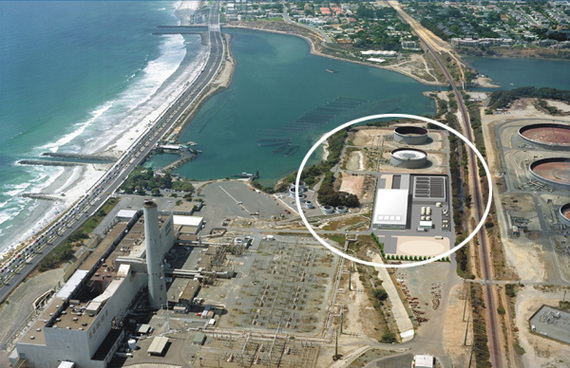The present drought in California is a highly visible realization of our lack of water awareness and its destructive undermining of the financial structure and social organization we have built in that most progressive state in that most successful global economy. If we fail in California, how can we succeed anywhere else?
At the most reductive level, the traditional water supply system in California has been overwhelmed by climate, industrial agriculture, and water-rich consumption that has been the envy of the world but can survive no longer without revolutionary change. If there is not enough water on the mountaintops to feed the watersheds, rivers, and reservoirs, then where will the requisite water come from?
In 2012, the San Diego County Water Authority signed an agreement to build the largest desalination plant in the United States. The process is not new; it is applied today in some 21,000 desalination plants in over 120 countries, including Italy, Australia, Spain, Greece, Portugal, Japan, China, India, United Arab Emirates, Malta, Cape Verde, and Cyprus, producing more than 3.5 billion gallons of potable water per day. Saudi Arabia leads the world, meeting 70% of the daily needs of its population.
The San Diego project is proposed to come on line in 2015 and to provide 7% of the Authority's demand by 2020. The plant is to be built and operated by Poseidon Water, a private investor-owned company that develops water and wastewater infrastructure. The contract is for 30 years, after which the Authority can purchase the plant for $1. The company is also building a 10-mile pipeline to deliver treated water inland to the Authority's aqueduct system where it can augment existing collected or natural supply to serve the needs of the 24 regional member water agencies serving 3.1 million people.
The Carlsbad Desalination Plant occupies 6 acres of the 388 acre ocean-front site of the Encina Power Station that for 50 years has run on oil and natural gas, releasing emissions, and requiring a large dredged lagoon to hold sea water for cooling and to receive plant effluent - a stagnant, stinking reminder of an old technology. The adjacent desalination plant will use a reverse osmosis process with its source water coming from the generating plant cooling supply, treated and pumped under pressure through membranes to remove salt and other microscopic impurities.
In the past, the primary objections to desalination have been salt residue, corrosion, habitat destruction, and cost. The Poseidon plant has undergone comprehensive review by the local, state, and federal agencies, each determined to protect its constituents and the environment. For every two gallons treated, one will be quality drinking water and the other diluted salt content for return to the ocean. The plant will run on Encina electricity to power high-speed pumps at market rates built into the contract. The approvals indicate that there will be no noise, no odor, and no environmental impact. Remarkably, the surrounding land has already been renewed by the prospect of the new plant and has been re-developed by the Authority to transform the embayment into a viable environment for marine life and community activities.
The San Diego region has been a center for the development of international desalination technology. The reverse osmosis process was born from a local company in the 1960s. There are some 35 related companies in the area employing 2,200 people and generating over $200 million in annual revenue. According to the Authority, the Poseidon Project "will have significant economic benefit for the region, including $350 million in spending during construction, 2,400 construction-related jobs, and $50 million in annual spending throughout the region once the desalination plant is operational. For the region, the facility will create jobs, generate tax revenue, improve water quality and enhance water reliability with a new drought-proof supply."
Drought-proof?
These hopeful numbers and language are the typical political arguments that have been used to justify new technology for a long time. The financial estimates may or may not be predicable or accurate, but the ultimate return is inevitable when there is suddenly no more water available, we need the salt water turned fresh, and the cost is priceless.

